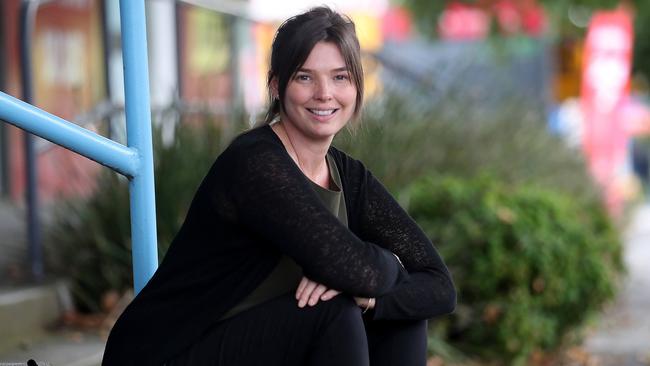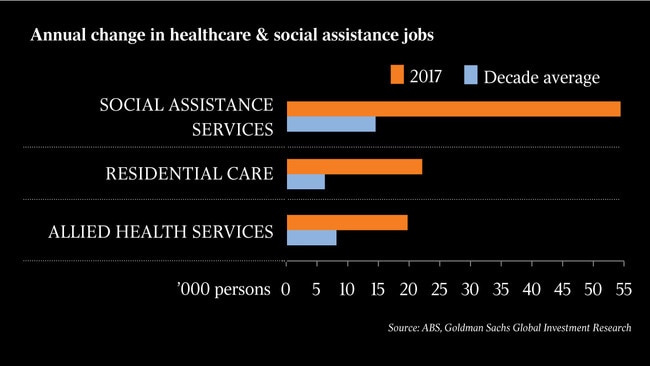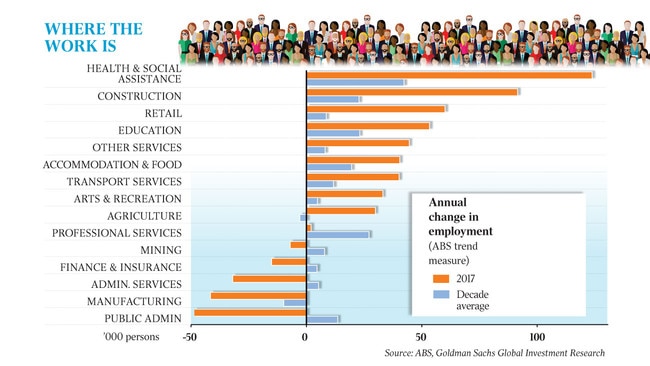Jobs boom driven by NDIS injection of taxpayer billions
The $22bn taxpayer-funded NDIS was responsible for as many as 52,000 of the new jobs created last year, new analysis finds.

The $22 billion taxpayer-funded National Disability Insurance Scheme was responsible for as many as 52,000 of the new jobs created last year, new analysis finds, suggesting quasi public sector employment is a big part of the “jobs boom”.
Up to 13 per cent of the 400,000 jobs created last year — a record increase — involved specialist healthcare and caregiver roles, according to analysis by economists at Goldman Sachs. These were in addition to 1950 jobs at the National Disability Insurance Agency, which administers the NDIS, including 43 executives and about 320 middle managers.
“We think there were probably about 50,000 additional jobs from the NDIS last year, and we might reasonably expect another 100,000 over the next few years,” said Andrew Boak, Goldman’s chief Australia economist.
The Turnbull government has singled out jobs growth, which at 3.3 per cent last year was more than twice population growth, as evidence the economy was improving. “There are better days ahead and those better days ahead are certainly true for 400,000 Australians who got a job last year: a record, a calendar year record, for jobs growth,” Scott Morrison said last week.

The unemployment rate fell only slightly in 2017 to 5.5 per cent, as the workforce participation rate of women — who tend to dominate the health and care sectors — rose rapidly. “Pretty much all of the swings in employment growth between 2015 and 2017 are in the healthcare sector. Strip that out and growth is on a gradual upward track,” JPMorgan economist Ben Jarman said.
Bill Shorten yesterday said jobs growth was happening “at the low end of the market where wages are not increasing”.
“A lot of the new jobs being created through the NDIS, a lot of those jobs are in irregular work, contract work, casual work and, of course, it’s a feminised industry,” he said at the National Press Club.
Mr Boak, who expects the unemployment rate to fall to 5 per cent by the middle of the year, stressed the job market was strong even without the NDIS. “Separating out all government sector or non-market jobs in the health, education and administration sectors, private sector or market jobs growth last year was 270,000, or almost three times the decade average and much higher than 2016,” he said.

Mr Jarman, however, said healthcare wasn’t a “bellwether” sector for the economy but was driven by government policy and ageing demographics.
Independent economist Saul Eslake said the NDIS represented a growing list of industries where the line between public and private was increasingly blurred. “Think of all the defence procurement jobs in South Australia, and the growing share of kids at private schools funded by government,” he said.
“Then there’s the share of construction work done for the public sector by the private sector, which has been growing steadily, too.”
Construction was the second- biggest source of jobs in 2017, providing about 90,000, while public administration, one of 16 groups tracked by the ABS, shed almost 50,000 workers.
The NDIS, which funds tailored care packages mainly for children and young adults with intellectual or social disabilities, is expected to cost $22bn a year by 2020, when the Productivity Commission estimates it will employ about 300,000 people.
Emma Barlow, 29, from Ringwood in Victoria, is among thousands of Australians who have made a career change in the past year thanks to the rollout of the NDIS. Ms Barlow spent seven years taking 000 calls and sending out ambulances to those in need before she decided she wanted to work in the disability services sector.
“I loved my time taking the 000 calls but I wanted something that was a bit more human … I wanted more face-to-face interaction,” she said.
She is now a senior local area co-ordinator for Latrobe Community Health Service, which provides NDIS services in Melbourne’s outer east, and spends her days working with people with disabilities and their families to arrange their NDIS plans and get them in touch with a range of services, from specialist medical care to support groups.
“I’m really loving it … it’s just so fulfilling being able to know you’re actually helping people,” she said.
“I was a bit surprised when I heard the amount of jobs the NDIS had created, but on reflection it makes a lot of sense. There’s so much work to do and it’s growing every day.”
The growth in NDIS work follows a burst of hiring by state governments in Victoria and Queensland.


